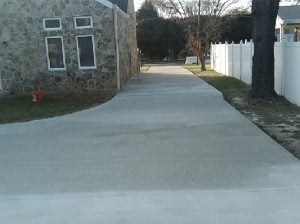We’ve finally had our first taste of Winter here in the mid-Atlantic, and there’s every reason to expect that it’ll stay cold for another two months, give or take. Many people assume you can’t place concrete in cold weather and that it’s best – if not necessary – to hold off on placing concrete until the weather turns again.The truth is, while we definitely need to take certain precautions to protect against some of the potential problems of placing concrete in cold weather, is is not at all necessary to wait. Follow the advice below, and get your concrete placing done now! Commonsense Tips for Working With Concrete:· Discuss with your ready-mix producer the possibilities of using hot water, heating the aggregates, increasing the cement content, or adding an accelerating admixture. · Order air entrainment if the concrete is exposed to freeze-thaw conditions during or after construction. · Plan ahead. Have insulation and heaters ready, and inform your ready-mix producer of what concrete temperature you’ll need for your project. · Don’t place concrete on a frozen subgrade; thaw the subgrade with steam or protect it with insulation. · Add a gallon of water per cubic yard of concrete to increase set time up to one-half hour; adding two gallons can increase set time up to an hour. · Provide triple insulation thickness at the corners and edges of walls and slabs. · Protect fresh concrete against the disruptive effects of freezing until the concrete attains a compressive strength of about 500 psi. Concrete gains very little strength at low temperatures. · Don’t expose concrete surfaces to a sudden temperature drop; gradually reduce the insulation or enclosure temperature to control concrete cooling (no more than a 50 degree F drop in 24 hours). · Avoid using unvented heaters; carbon dioxide from the heaters can cause soft, dusting floors. · Keep heaters attended at all times; they are a fire hazard when burning and are of no value when out of fuel. · It is good practice in cold weather to leave forms in place as long as possible. Even within heated enclosures, forms serve to distribute heat more evenly and help prevent drying and local overheating. There’s Nothing You Can Do That Can’t Be DoneConcrete that has been frozen just once at an early age can be restored to nearly normal strength by providing favorable curing conditions. Such concrete, however, is not as resistant to weathering, nor is it as watertight as concrete that has not been frozen. If concrete is frozen and kept frozen at about 14 degrees F (-10 degrees C), it will gain strength slowly. Below that temperature, cement hydration or concrete strength gain ceases. |
Trust Testa Paving for Your Winter Concrete Projects!
If you are in the need of concrete services, Testa Paving Inc. is here to help! For over 35 years, Testa Paving Inc. has been a driving force within the industry and has been serving the areas of Maryland and northern Virginia.
Interested in one of the services offered by Testa Paving Inc.? Call us today at 301-663-5861 or visit our contact page.
Be sure to click “Like” or “Follow” on our official Pinterest, Google+, Facebook, and Twitter pages today!

